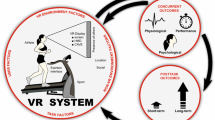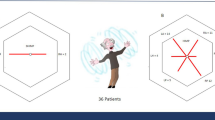Abstract
Twelve ballet dancers with various levels of dancing experience and skill were examined with the visual suppression test using post-rotatory nystagmus (PRVST) and caloric stimulation (CVST). The PRVST results showed a suppression rate that was higher than in untrained subjects. The CVST results showed a suppression rate similar to that in untrained subjects. A correlation between the PRVST and CVST suppression rates and the length of dancing experience showed that the suppression rate increased as the level of experience and skill rose. These results indicate that the PRVST and CVST can aid in the clinical and quantitative assessment of the function of the central nervous system in visual-vestibular interactions in ballet dancers. Additionally, testing may have determined function of vestibulo-cerebellar pathways through habituation of visual-vestibular interactions. Findings indicate that it may be possible to use suppression rates of PRVST and CVST to determine the approximate level of a dancer's experience and skill.
Similar content being viewed by others
References
Andre-Thomas M (1940) Equilibre et equilibration. Masson, Paris
Cohen H, Cohen B, Raphan T (1992) Role of the flocculus and paraflocculus in optokinetic nystagmus and visual vestibular interactions: effect of lesions. Exp Brain Res 50:9–33
Collins WE (1966) Vestibular response from figure skaters. Aerosp Med 37:1098–1104
Collins WE (1974) Habituation of vestibular responses with and without visual stimulation. In: Kornhuber HH (ed) Handbook of sensory physiology, vol VI/2. Springer, Berlin Heidelberg New York, pp 369–388
Dodge R (1923) Habituation to rotation. J Exp Psychol 6:1–35
Fukuda T (1983) Statokinetic reflexes in equilibrium and movement. University of Tokyo Press, Tokyo
Halstead W, Yacorzynski G, Fearing F (1937) Further evidence of cerebellar influence in the habituation of after-nystagmus in pigeons. Am J Physiol 120:350–355
Hood JD, Pfaltz CR (1954) Observations upon the effects of repeated stimulation upon rotational and caloric nystagmus. J Physiol (Lond) 124:130–144
Lisberger SG, Miles FA, Zee DS (1984) Signals used to compute errors in monkey vestibuloocular reflex: possible role of flocculus. J Neurophysiol 52:1140–1153
Magnus R (1924) Körperstellung. Springer, Berlin
Singleton GT (1967) Relationships of the cerebellar nodulus to vestibular function: a study of nodulectomy on habituation. Laryngoscope 77:1579–1620
Takemori S (1976) Increase of visual suppression as compensation after unilateral sudden loss of inner ear function. Auris Nasus Larynx (Tokyo) 5:101–107
Takemori S, Cohen B (1974) Visual suppression of vestibular nystagmus in rhesus monkeys. Brain Res 72:203–212
Teramoto K, Sakata E, Ohtsu K, Yamashita H (1986) New visual suppression test making use of rotatoric stimulation as a milder one. In: Claussen C-F, Kirtane MV (eds) Vertigo, nausea, tinnitus and hearing loss in cardio-vascular diseases. International congress series 708. Excerpta Medica. Amsterdam, pp 319–324
Tokita T, Taguchi T, Matsuoka T (1971) Telemetering of eye and head movement in ballet rotation. Equilibrium Res [Suppl] 1:49–59
Waespe W, Cohen B, Raphan T (1985) Dynamic modification of the vestibulo-ocular reflex by the nodulus and uvula. Science 228:199–201
Author information
Authors and Affiliations
Rights and permissions
About this article
Cite this article
Teramoto, K., Sakata, E. & Ohtsu, K. Use of the visual suppression test using post-rotatory nystagmus to determine skill in ballet dancers. Eur Arch Otorhinolaryngol 251, 218–223 (1994). https://doi.org/10.1007/BF00628427
Received:
Accepted:
Issue Date:
DOI: https://doi.org/10.1007/BF00628427




